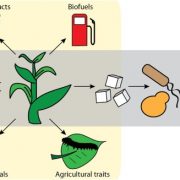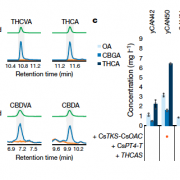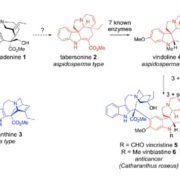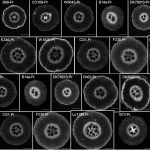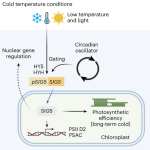Regulated and optimized control of insect pheromone biosynthesis in plants
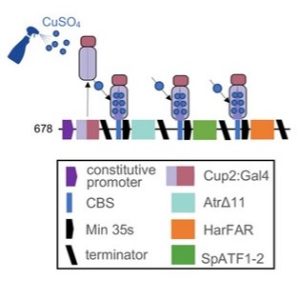 Insect sex pheromones, volatile molecules used to attract mates, are used commercially to disrupt breeding behavior of insect pests and can be a good alternative to harmful pesticides. These pheromones have been produced in plants at a low amount and shown to be released as volatiles, but their production levels can be improved and refined. Kallam et al. used metabolic engineering to improve pheromone production in tobacco plants six-fold by using yeast enzymes in the biosynthesis pathway. The authors also showed that a combination of a low-cost copper-inducible system on dead CRISPR-Cas9 (dCas9) fused to a transcriptional activation domain gave a tight upregulation on pheromone production, alleviating growth-inhibitory effects that can arise from consitutive production. Transient expression through Agrobacterium-infiltration yielded the highest amount of pheromone due to high copy number plasmids, outperforming stable lines that require the selection of high-yielding strains and overcoming regulatory barriers. This paper shows great potential of tunable insect sex pheromone production in plants. Furthermore, the modular genetic elements described here are more broadly useful to the design of constructs for plant metabolic engineering. (Summary by Yen Peng (Apple) Chew @_applechew) Plant Biotechnol. J. 10.1111/pbi.14048
Insect sex pheromones, volatile molecules used to attract mates, are used commercially to disrupt breeding behavior of insect pests and can be a good alternative to harmful pesticides. These pheromones have been produced in plants at a low amount and shown to be released as volatiles, but their production levels can be improved and refined. Kallam et al. used metabolic engineering to improve pheromone production in tobacco plants six-fold by using yeast enzymes in the biosynthesis pathway. The authors also showed that a combination of a low-cost copper-inducible system on dead CRISPR-Cas9 (dCas9) fused to a transcriptional activation domain gave a tight upregulation on pheromone production, alleviating growth-inhibitory effects that can arise from consitutive production. Transient expression through Agrobacterium-infiltration yielded the highest amount of pheromone due to high copy number plasmids, outperforming stable lines that require the selection of high-yielding strains and overcoming regulatory barriers. This paper shows great potential of tunable insect sex pheromone production in plants. Furthermore, the modular genetic elements described here are more broadly useful to the design of constructs for plant metabolic engineering. (Summary by Yen Peng (Apple) Chew @_applechew) Plant Biotechnol. J. 10.1111/pbi.14048



